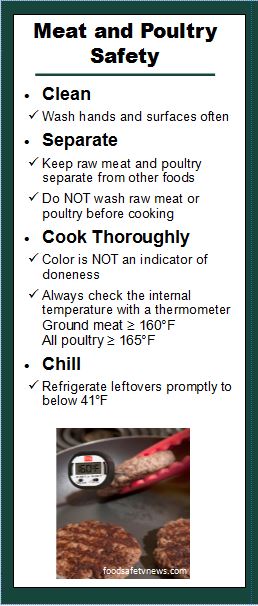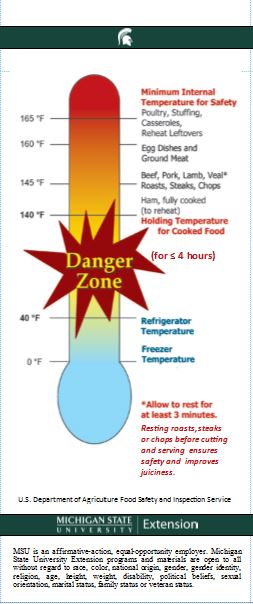Become a grillmaster by using a food thermometer
Meat quality and the overall eating experience can be improved by using a food thermometer to determine doneness and improve safety at the same. time
At first inquiry about using a thermometer to measure the degree of doneness in meat and poultry products, it's common to glean a lot of blank stares, or those that quickly look the other way, and a few other that may nod their heads in either direction. The issue of using a meat thermometer to prevent food-borne illness is critical (Figure 1).
Meat and poultry safety. All images by Jeannine Schweihofer.
The message is consistent, from Michigan State University Extension or from the U.S. Department of Agriculture. Cook ground beef (and other ground meats), at 160 degrees Fahrenheit (Figure 2). All poultry needs to be cooked to a minimum of 165 degrees Fahrenheit. Those endpoint temperatures make the products safe. One attention grabber is the fact that the center of a ground beef patty can appear done but's actually raw, while a pink center in a hamburger could be fine. Color is not an indicator of doneness in ground meats! All beef, pork, lamb, and veal steaks, chops and roasts should be cooked to a minimum internal temperature of 145 degrees Fahrenheit and held for three minutes (Figure 2).
Proper endpoint temperatures for meat and poultry.
If you're a meat eater, ask yourself, "What's needed for a pleasurable meat eating experience?" Safety isn't typically at the top of the list (kudos to those who answered with safety! ) Flavor, tenderness or juiciness are the normal top answers. Personal preference determines which of those three attributes one selects. Responses are about equal for flavor, tenderness and juiciness from most consumers. Tenderness and flavor are impacted by several things, including species (beef, pork, lamb, chicken), cut (steak, roast, leg), age of animal (younger animals have less connective tissues and are generally more tender), what and for how long the animal was fed (grain vs. grass) and more. Although juiciness can be influenced by many of the actors that impact tenderness and flavor, cooking method and degree of doneness can significantly alter juiciness.
Farmers and ranchers work hard over months or years to raise a safe, high-quality product for consumers' enjoyment, but that high-quality product can be ruined in an instant if it's overcooked. Have you ever eaten a steak that's cooked more than your liking? Proper endpoint cooking doesn't have to result in an unpleasant eating experience. Just the opposite is often the case, Instead of making a slit into the center of a steak on the grill to fine out if it's done and instantly releasing a flood of juices, slide a thin, instant-read thermometer into the side of the cut. To cook a steak to medium rare (145 degrees Fahrenheit), it typically can be pulled from the grill at 140 degrees Fahrenheit since the internal temperature will continue to rise for a short time after the steak or chop has been removed from the grill or heat source. Remember to let steaks and chops rest for three minutes after cooking. Larger cuts like prime rib roast need to rest for 15 to 20 minutes and will typically rise at least 10 degrees after being removed from the heat. That means to cook a prime rib to medium rare, pull it at 135 degrees Fahrenheit and leave it tented with foil for the rest period. Resting meal allows the muscle fibers to reabsorb the juices released during cooking and seals them into the meat instead of running all over the plate when it's first cut. Resting meat also ensures safety by achieving the needed time and temperature combination.
Have you ever eaten a dried out hamburger? Try cooking one to 160 degrees Fahrenheit. Experience and research indicated that it'll likely be juicy and sometimes a little pink inside. Remember, color isn't an indicator of doneness in ground meats. Grillmasters understand the importance of using a food thermometer to prepare the best cut of meat you've ever eaten!



 Print
Print Email
Email





